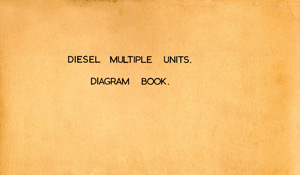Diagrams

Each vehicle type was allocated a diagram number to identify its design. This was a three figure number prefixed "BR". Note that the diagram number also refers to the page number in the diagram book.
BR issued diagram books for each type of stock such as "Locomotives", "Carriages" and of course a "Diesel Multiple Units" version. They were landscape foolscap size in a format that allowed pages to be added, removed or replaced to keep the books up-to-date. For a further more general look at BR's diagram books check out this Barrowmore Model Railway Group page.
I've split the diagram listings over several pages to make them managable. Where I've found different versions of the same diagram I've included these too.
Most of the scans are from the original book I have, some are scanned from photocopies of photocopies so are of lesser quality. If you have a better quality copy, or any other variations I'd be grateful for a scan so I can keep these pages as complete as possible. Similarly, there are a few unknown diagrams that may have been deleted (in particular diagram 519 is a glaring ommission, 575, 576 and 578 are others), and there are probably later additions added as alterations were done which are missing, I'd appreciate being able to fill any gaps.
The book also included DEMU vehicles and HST prototype vehicles (amongst others) and while I've listed these to identify what the diagrams are I haven't included the actual page scans as they are outwith the scope of this website.
There are errors on some pages, two of the most obvious being 571 where the plan view is a mirror image of the interior, and 607 where the plan is a mirror image of the whole vehicle.
The diagrams were created from each builder's general arrangement drawings - as can be determined by differences in styles.
Analysing the diagrams there seems to be little logic to the allocation of diagram numbers, in the sense that it would be expected that the earlier types would have the lower numbers, and later design higher numbers. There are certain "groups" of vehicles (such as Swindon built types) but nothing that makes any real sense.
This seems to indicate that the diagram numbers were allocated after all the vehicles were ordered / delivered. Another clue to this is there also exists some diagrams that show complete formations. They use the same number series and seem to be close to the actual order / delivery sequence. I suggest that this complete formation system was used initially, then they were all revised to feature just single vehicles (perhaps when formations started being mixed by interchanging vehicles). The ACV 4-wheeled vehicles (diagrams 500 / 506) kept the same diagram in both series. The formation diagrams that I've encountered can be found here, and again I'd be grateful for help in filling any blanks.
Please select from the list below the diagrams that you'd like to view, or use the next link at the bottom right of the page to work your way through each page:
Diagrams 500 - 519
Diagrams 520 - 539
Diagrams 540 - 559
Diagrams 560 - 579
Diagrams 580 - 599
Diagrams 600 - 619
Diagrams 620 - 639
Diagrams 640 - 659
Diagrams 660 - 679
Diagrams 680 - 694
Diagrams 850 - 858
I've also encountered an early index for the above.
In 1980 the diagram books were revised and the original page numbers were replaced by "design codes". These had a two page layout, in most cases the same drawings were used.


